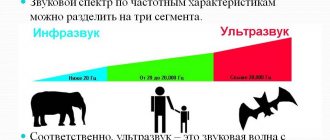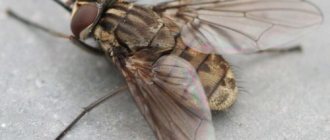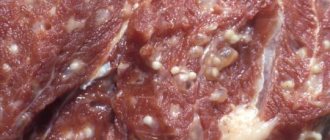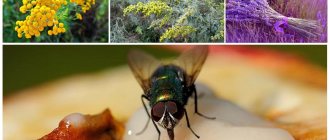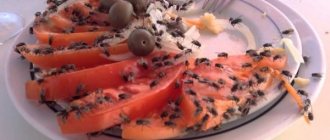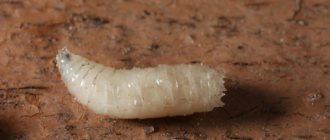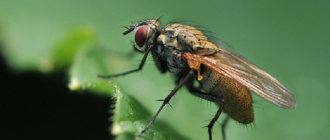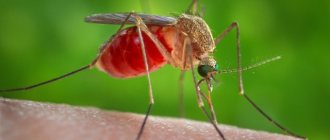What do flies like?
At home, several species of flies live near humans.
The most common house fly is the house fly. The synanthropic species is not adapted to life in the wild; it feeds on almost everything that humans eat, as well as garbage, waste, and excrement. The insect prefers liquid food because it is absorbed faster; pests love sweet dishes. They are attracted to products that show signs of rotting. There are also dishes that flies prefer, and those that are eaten if there is nothing better.
Favorite dishes:
- fruit, vegetable juice;
- jam;
- syrup;
- sugar;
- compote;
- lemonade;
- honey.
Without much enthusiasm, but if necessary, he eats a fly:
- sausage;
- porridge;
- borsch;
- soup;
- fermented milk products;
- mashed potatoes;
- candies;
- cakes;
- fruits;
- vegetables.
On a note!
Flies in the house feed on everything they can get their hands on. Initially, they absorb liquid foods, since less energy is spent on digesting such food, then they move on to solid foods. To be completely satiated, an adult needs only to drink a drop of juice and eat a bread crumb.
Feeding flies
Diet of flies
The diet of house flies, which are practically not adapted to feeding in the external environment, consists of leftover food consumed by humans, various wastes, and feces.
Insects prefer liquid food. They most readily eat fruit and vegetable juices, various syrups, compotes, and jam. Less often, he pays attention to soups, borscht, and fermented milk products.
In the absence of liquid food, flies consume honey, sugar, ripe and lost fruits and vegetables. They do not disdain sweets, sausage, cereals, and potatoes. They first dissolve semi-solid and solid food with saliva, after which they hold the substrate in the mouth for some time and absorb it in liquid form.
Green, gray or blue blowflies, which sometimes fly into living spaces, in addition to the standard diet for a household pest, readily feed on biological fluids left over from fish, meat, and decomposing waste, including feces.
In the external environment, ordinary house flies do not fly far from human habitation. In nature, they feed on plant nectar, food waste in landfills, and livestock feces. They can be regularly found in open markets where vegetables, fruits, meat, and fish are sold.
Nutritional Features
The official classification of flies used by scientists is based on the feeding habits of adult insects. Based on what flies eat at home and in the wild, they are divided into:
- necrophages,
- coprophages,
- nectarivores,
- hematophages,
- polyphages.
Attention! Houseflies are polyphagous - they are omnivorous in nature. Preference is given to organic food with a distinct smell. They do not disdain rotting, decaying products.
Flies eat both liquid and solid food, but they prefer the first option. Before eating a solid product, the insect will have to spend some time producing saliva (to wet the food).
Diptera insects have no teeth; they absorb food with their proboscis. This organ is a kind of “structure” consisting of 2 tubes. The fly uses them to suck up food.
Before feasting on a particular product, the insect tastes it. For this purpose, there are special taste buds at the tips of the paws.
On the antennae of flies there is a group of neurons responsible for the sense of smell. Therefore, insects do not find food by chance, but purposefully follow a smell that is pleasant to them.
The structure of the fly's mouthparts
Non-bloodsucking house flies are more common in apartments. They have a specific structure of mouthparts designed to feed on liquids or substrates that dissolve in the creature's saliva.
The main feature of the muscoid oral apparatus is the change and hypertrophy of the lower lip of the organ. At the same time, the insect's jaws and upper lip are atrophied. Externally, the oral apparatus looks like a proboscis, attached to the sclerites of the head and jaws. They ensure the flexion of the oral organ and its position above the head.
The main part of the proboscis is the rostrum. Along its edges there are paired plates and palps, supplemented by a clypeus. Direct capture of food is carried out by the lower lip, which looks like an open gutter with a subpharyngeal gland. Through it, the fly sucks in food and secretes saliva.
House flies consume nutrient liquids and food suspensions - products of decomposition of organic matter. Semi-solid food reaches the insect after being processed by saliva. The household pest releases it onto the surface of the food, waits for it to dissolve, and then absorbs the result in liquid form.
Feeding process in flies
What do flies eat? These dipterans are considered practically omnivorous. And the lack of teeth is not a hindrance. The feeding process involves a long proboscis - a kind of tongue divided into two tubes. It is through them that the food that the fly eats is absorbed.
Feeding process in flies
This is interesting, but without exaggeration these insects can be called gourmets - they do not eat everything. On the paws of an adult individual there are taste buds that allow you to taste food before the proboscis gets involved.
What do flies eat in the house? It is most convenient for insects to eat liquid food, since solid food is more difficult to eat. The indoor snack lover spends too much energy on eating and digesting it: first, solid food is abundantly moistened with saliva, and only then penetrates the digestive tract.
Typically, these dipterans are not capable of sucking human blood, but the mouthparts of the housefly, which is very similar to a housefly, are designed in a special way. The proboscis, strongly elongated and equipped with chitinous “teeth” at the end, scrapes off the epidermis by friction and lets saliva into the puncture. The zhigalka not only feeds on blood, but also leaves irritation at the site of the bite.
Appearance and internal structure
At first glance, the body structure of a fly seems simple, but in fact, many institutes have been studying these insects for a long time. The body of a fly consists of three parts: head, thorax and abdomen. The lower part of the head has a yellow tint. The following organs are located on it:
- Eyes. In the fly they are quite large and consist of many small simple eyes that form a faceted network. The image obtained using facets has the appearance of a mosaic.
- Oral apparatus. Insects have powerful jaws and a proboscis. Food enters through the lobes of the upper and lower lips. A large number of tubules connect at the central point of the proboscis. In species that feed on blood, the structure of the oral apparatus contains sharp plates with which the insect pierces the skin of the prey.
- Mustache. This organ helps to navigate in space and smell. The antennae of females and males may differ.
The chest has three segments, the second segment being the most developed. On the chest there are 3 pairs of limbs, which consist of 5 segments. The legs of flies are equipped with developed muscles, claws and suckers. When the fly walks, the pads of its feet secrete a sticky liquid. The paws perform another function - they analyze the quality and taste of food.
The front pair of wings is well developed, has a membranous structure, the hind wings are deformed and form halteres. With the help of these appendages, the fly can hover in the air and maintain balance.
The cylindrical abdomen consists of 10 segments. The chitinous shell of flies tends to stretch when saturated and during pregnancy.
The most important internal organs are located in the abdomen. The reproductive system is represented by ducts, accessory glands, as well as eggs or testes, depending on the gender of the individual. External appendages differ from species to species.
Females lay clutches of eggs; their number per clutch can range from 70 to 150, depending on the species. In the family of corpse flies there are viviparous ones.
The digestive system is represented by the goiter, intestines, Malpighian vessels and excretory tubules. Food is digested before absorption; for this, the insect introduces a special digestive secretion into it.
The respiratory organs include a large number of tracheae, which are distributed throughout the body. Their opening to the outside is ensured by spiracles.
The brain is made up of many neurons. The circulatory system includes the heart, aorta, pterygoid muscle and dorsal vessel. Blood is colorless and transports nutrients.
Classification of flies: types and nutritional groups
The number of species of dipterous insects, which include flies, numbers several thousand. Some of them are synanthropic, i.e. they tend to live closer to people and consume waste, while others live in the wild (forests and fields) and are constantly searching for food.
According to the organization of the feeding process, flies are divided into 3 groups:
- hematophagous (bazaar, zhigalka, tsetse, etc.) - blood-sucking, such flies in nature feed on blood, ichor and sweat, the diet of the larvae consists of excrement;
- nectarophages (wohlfart fly) - for adult individuals, plant juices serve as food, less often - animal droppings, the larvae develop and feed on organic tissues, since the female lays eggs on wounds and mucous membranes of animals and humans;
- coprophages (pasture, house) - they feed on food waste or excrement, in nature they can also consume plant juices;
- necrophages (meat), in which adult individuals feed on corpses, as well as food and meat waste, excrement;
- polyphages (indoor, etc.) - are omnivores, consuming food products and waste of plant and animal origin, as well as waste products of living organisms, discharge from wounds and mucous membranes as food.
Interesting!
Among the types of flies there are also predatory ones (ktyri), which feed on mosquitoes, cats and even bees. And there are those who eat cheese heads all their lives, their larvae - cheese flies - multiply and grow in them.
Nutrition of larvae
The diet of fly larvae also depends on the species of diptera. In nature, flies lay eggs in places where the larvae that emerge from them can immediately begin to feed, that is, closer to rotting garbage or the remains of living creatures.
The main food for housefly larvae is plant juices of rotten fruits and vegetables, excrement and decomposing food waste.
Meat-bearing species of dipterans prefer to lay eggs in rotten remains of meat, fish or offal. The hatched larvae perform the function of orderlies, since they eat large quantities of waste and carrion, due to which they quickly grow in size and develop, turning into pupae and adults (imago).
Feeding the burners
Autumn burner flies are found on all continents, but more often they settle in places where animals (cows, sheep, etc.) are kept. They appear at the end of summer and early autumn, and with the onset of cold weather they can move closer to human habitation.
The main diet for live baits is blood. To get to it, they have chitinous teeth, with which they scrape off a small piece of skin from the victim to get to the blood vessels.
Important!
They prefer the blood of cattle, and are capable of biting a person only if they accidentally enter his home. This species is dangerous for people because it is capable of carrying infections that are transmitted through the blood (ulcers, trypanosomiasis, tularemia, etc.), after introducing bacteria into the wound, they contribute to the development of sepsis (blood poisoning).
What do autumn flies eat?
Very annoying flies often live near a person’s home, the number of which increases in the fall. These are zhigalki, their main food is blood. “Donors” of these insects are not only cattle, but also pets (dogs, cats, hamsters) and people.
Zhigalki are hematophagous, and this species of dipteran insects has chitinous plates on the proboscis. With them, the fly bites through the skin to get to the blood vessel.
Important! By feeding in this way, the insect can introduce pathogens of dangerous diseases into the human body.
Ecology of flies
Among the flies there are both inhabitants of the wild and synanthropic species that live near humans. According to the degree of connection with humans, flies are divided into village, semi-village and pasture flies.
Village species are confined to populated areas. They live and reproduce exclusively in the village. Some species, such as the housefly (Musca domestica), are closely related to humans. They live in or near residential areas. They feed on human food, licking sweat, as well as secretions from mucous membranes and wounds. Human feces and food waste serve as sites for the development of larvae. The absence of domestic animals in the habitats of such species does not in any way affect their livelihoods. Other species, on the contrary, are confined only to those populated areas where there are livestock. The connection between such flies and humans is through domestic animals. The source of food for adults is animals, less often humans. The larvae develop in manure. An example is the blood-sucking autumn fly (Stomoxys calcitrans).
Semi-settlement or facultative-settlement species live both in populated areas and in natural conditions. An example of this group is all types of blowflies.
Pasture flies can also fly into settlements, the larvae of which develop in livestock droppings on pastures.
Synanthropic flies
For humans, synanthropic flies (flies ecologically associated with human settlements) are of greatest importance (and pose the greatest danger to human health). These include, first of all, representatives of the following families: Muscidae - true flies, Calliphoridae - blue or green blowflies, Sarcophagidae - gray blowflies, Piophilidae - cheese flies, Drosophilidae - fruit flies, fruit flies, Hippoboscidae - bloodsuckers and representatives of three families gadflies: Gastric gadflies (family Gasterophilidae), Subcutaneous gadflies (family Hypodermatidae) and Cavity gadflies (family Oestridae)
What do flies eat in the house?
Diptera polyphags, which include the familiar house flies, are not picky about food. Insects can be seen on food products, in places where animal and plant waste accumulates.
Flies are not averse to feasting on human and pet feces, as well as secretions from mucous membranes (tears, saliva) and festering wounds.
Among house flies there are also coprophages. They live in garden plots, in pastures, and also fly indoors. These flies tend to feed only on animal and human excrement.
Housefly diet
Although flies are omnivores, they give preference to sweet and tasty food and dishes.
List of foods that flies love:
- fruit and vegetable juices;
- compotes and sweet lemonade;
- sweetened tea;
- jam, honey and jams.
They can also feed on leftovers from any food products and dishes:
- sausage;
- soups, porridges, borscht;
- mashed potatoes;
- cakes and sweets, etc.
On a note!
For complete saturation, flies need very little: a bread crumb or a drop of juice. However, you need to eat often, so insects are constantly in the process of searching for food, flying from one place to another.
In the absence of fresh food, they find rotting fruits or vegetables, leftover food in the trash can, etc.
What does a blowfly eat?
As their name implies, the main diet consists of meat, lard, as well as carrion and the flesh of dead animals (in the forest or in nature). Adults and their larvae can consume other foods:
- rotten fruits and vegetables;
- grasshopper larvae, beetles.
Due to the fact that blowflies land with their paws on corpses and rotting food, they become carriers of infectious diseases. However, in nature they are beneficial, destroying rotting remains (they can completely eat the corpse of a small rodent) and accelerating the decomposition processes of animal corpses
Lifespan
We looked at what the Drosophila fly and some other species of these dipterans feed on. Let's find out how long they live and whether they can live without food.
The average lifespan of fruit flies under favorable conditions is short, only 10-20 days. However, if the temperature is up to +18 °C, and there is a lot of food, pests can live for more than 2.5 months. Diptera are almost never left without food, since they find food everywhere both in human homes and in nature. If necessary, they can eat food in garbage dumps and landfills. In winter, the insect goes into suspended animation and can survive without food until the first warm days. It should be remembered that newly awakened flies are very lethargic and it will not be difficult to kill them.
In forests, dipterans have a lot of natural enemies (birds, frogs, spiders), so they rarely survive more than 10 days.
We looked at what flies eat and were convinced that these creatures are able to survive almost anywhere, since they are not picky about food.
Housefly: life expectancy, favorable conditions
The development of the insect occurs in three stages, the duration of which is 8–20 days. The lifespan of flies is two to four weeks, some of them live up to two months.
The lifespan of a fly depends on the conditions
ovy environment. The thermal preference of M. domestica L. is 32–44ºС. The optimal temperature for insect existence is 23–25ºС.
The lifespan of a fly increases if it survives the winter season in a cold room. Adult fertilized females, pupae and larvae survive the cold season in an inactive state. Insects awaken in the spring, when the maximum daily air temperature outside is 10ºC.
Some interesting facts
Among these insects there are many species with unusual feeding preferences. Let's look at what flies eat in natural conditions:
- There is a special type, cheese flies, that can breed and feed inside the cheese wheel. They are called pyophilides.
- The striped yellow-and-black syrphid, or hoverfly, a wasp-like dipteran, eats flower nectar.
- The larvae of hover flies are distinguished by an enviable appetite: during their development to an adult, each of them eats more than 2 thousand aphids.
- The dangerous Tsetse fly prefers the blood of wild animals, cattle, and people as food. The bite of this African resident can cause incurable diseases of the nervous system and immunity.
Among the flies there are also real predators, for example, ktyri, owners of a sharp poisonous sting. Their food includes mosquitoes, midges, even bees and flies. Interestingly, some types of flies are cultivated by fishing fans. Thus, the blue spring fly is specially bred on bird droppings, pig manure, its food is rotting organic remains, and the insects are also fed with sugar and dry milk.
Sources
- https://apest.ru/muhi/o-muhah/chem-pitayutsya-muhi/
- https://WikiParazit.ru/babochki-i-moshki/pitanie-muh.html
- https://komarmuha.ru/chto-edyat-muhi
- https://dezbox.ru/dezinsekciya/chem-pitayutsya-muxi-v-domashnix-usloviyax/
- https://klopkan.ru/muhi/chem-pitayutsya-muhi-v-prirode-iv-domashnih-usloviyah/
- https://notklop.ru/muhi/2-fakty/29-chem-pitayutsya-muhi/
- https://bioros.net/vsyo-obo-vsyom/chem-pitayutsya-muhi.html
- https://www.syl.ru/article/362975/chto-edyat-muhi-raznoobraznyie-lakomstva-dlya-dvukryilyih
[collapse]
Feeding chameleons at home
Exotic lizards living at home require a special diet. Reptiles cannot eat the usual foods typical of the human diet. Despite the fact that a certain part of the menu still consists of vegetables and fruits, the priority food for a chameleon is food of animal origin.
Food of animal origin
Animal products for a chameleon are insects. The most useful food is crickets and locusts.
What other insects can you feed a chameleon:
- feed cockroaches;
- grasshoppers;
- flies;
- spiders;
- May beetles;
- dragonflies;
- Zophobos, wax moth larvae and mealworms can be given 3-4 times a month (frequent feeding of these insects can cause liver failure).
Large species of chameleons can be fed with small mice. This treat should not be given to your pet more than 2 times a month.
Plant-based foods and vitamin supplements
Domestic lizards can be fed with plant food - green leaves, vegetables, and some types of fruits.
What can you give your chameleon:
- green lettuce leaves;
- dandelions;
- grape;
- cherries;
- bananas;
- melons and watermelons;
- tangerines, oranges;
- kiwi;
- apples.
Special mineral and vitamin supplements are created for domestic reptiles to ensure a complete diet and maintain physical health.
Useful vitamins for chameleons:
- Calcium is an extremely important element for the reptile body. It strengthens bones and improves dental health. With its deficiency, metabolic bone disease (rickets) develops.
- Phosphorus is a useful component that regulates the correct balance of vitamins and minerals in the body. It must be consumed in the correct ratio with calcium.
- Vitamin D3 – strengthens the immune system, maintains normal levels of calcium and phosphorus in the lizard’s body.
- Vitamin A – ensures the normal functioning of the visual organs, supports bone health and immunity.
Even the healthiest vitamins and minerals in excess can cause serious health problems. An excess of phosphorus contributes to the development of heart and kidney failure. High levels of vitamin A lead to nervous system disorders and liver problems. Vitamin D3 in large quantities negatively affects the condition of muscles and nerves.
The optimal solution is to purchase special food with the correctly selected ratio of beneficial microelements.

